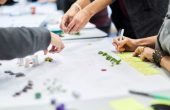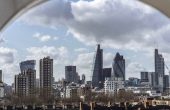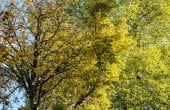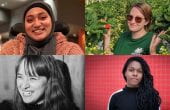A Guest Post by Helen Storey
Today the UNHCR marks ‘World Refugee Day’ – a moment to reflect and pause, and consider the role that we all have to play in this crisis. Just as pressure is beginning to build on governments to declare a climate emergency, we also have to consider the consequences for the mass displacement of people, and how climate change will accelerate this process. It was exactly for these reasons that I created Dress for our Time, a project which started out as a piece of fashion activism and an installation to highlight these issues. As an artist and designer I have spent the last 20 years exploring the ways fashion can facilitate social change – and never has change been so urgently needed by so many people.

Back in 2015, after discussions with the UNHCR, I was gifted a decommissioned refugee tent which I made into a dress. In giving the tent a meaningful reincarnation as a public installation, Dress For Our Time transcended both data and fashion by humanising the numbers to tell a bigger story. It was first shown at St Pancras during COP 21 and then went on to make appearances at the Science Museum, Glastonbury Pyramid Stage, Venice Biennale and at the UN HQ in Geneva – the dress provoked debate and important conversations around climate change and the mounting refugee crisis.
As the project evolved I became increasingly fascinated with where the tent had come from, unanswerable questions I received from children, took me to Za’atari – where the tent had once been home to a fleeing Syrian family. I learned fast, that the first person you meet in camp is yourself, your beliefs, your defences, ultimately, whether you like it or not, your purpose in life. The moment that I stepped into the camp everything changed. As we drove along the surrounding camp wall, in the 40 degree heat of summer, I could see people squatting in the width of its narrow shadow, their torsos hugging the perimeter. They were surfing on the edge of the base camp Wi-Fi, in order to communicate with relatives they could no longer be with. My priorities changed almost immediately and I started to find ways to empower the women and children in the camp through nurturing entrepreneurship, creativity and financial independence through the lens of fashion.

My first meeting with the manager of Za’atari Camp was enlightening. Nothing you can imagine, is how things actually are – he told us that the refugees have taught them the conditions for dignified living. The camp was built day-by-day, by the refugees themselves, and the UNHCR are in service to them. To express both the abundance of skills the refugees have (engineers, teachers, scientists, farmers, economists, athletes, tailors, barbers, chefs) and the conditions for their lives, one of his opening lines to us referred to the idea of ‘how to be an entrepreneur in hell’.

The facts are unprecedented in modern times – home for now, to almost 80,000 people, living off 35 litres of water per person, per day (1% of USA consumption), with 20 weddings a week, 3,000 ‘pop-up’ shops, five hospitals, 24 schools, 55,000 loaves of bread baked each night, 60-70 children born a week and a daily running cost, met by the UNHCR and the Jordanian government of £300,000. These are the experiences, which make you question everything. I wanted to respond directly to the needs of the people I met and help to address educational, livelihood and enterprise creation opportunities.
By the end of 2018, working alongside colleagues at London College of Fashion, UAL and with corporate partners such as Unilever and Givaudan we were delivering projects in garment making, jewellery design, perfume & soap creation and delivering make-up and beauty training. This led to the UNHCR creating a unique role for me as UNHCR Artist in Residence, this unprecedented opportunity has allowed me to embed myself in camp and co create new ways of working, which have suggested a new dialogue between the displaced, higher education, NGO’s, government and business – it’s emerging as a template for how fashion and art can be used as a powerful tool for social and economic development. In a world where aid budgets are shrinking exponentially, finding new models of development,in this new climate of uncertainty is crucial.

Over the past 6 months the UNHCR have been helping refugees in Za’atari to transition from aid, towards trade. The emotional temperature of the camp is therefore shifting; there has been a gap in time between preparing for this change on the one hand and the investment required in advance to help refugees make this transition. The priority to earn money now takes understandable priority over everything else, so we need to ensure that activity in camp moves faster towards monetisation. With this in mind we have concentrated on co-created collaborations and interventions, to create unique products, new business models and routes to markets (local and international), as a new form of urgency takes hold. Bringing together all we have learned over the last 3 years, we opened our first centre for the creative and economic empowerment of women in March this year; a centre which places Motherhood and enterprise in equal union – today we release a film (LINK) about the opening, which for everyone involved, was a small miracle.
The people of Za’atari do not want the world to forget them – in a place full of people for whom geography and circumstance has dealt a blow none of us in the UK can imagine, there is much to be inspired by. I am fortunate to be able to use my privileges to find ways to listen and amplify the voices of the people of Za’atari and tell their story.
Out of the black shatter of war, and equal in the trauma that unites them, refugees show us how to live in a way, where every single action matters and everything in a lived day, is an utter achievement. They are on the frontline of all our futures.
To follow Helen and her day to day life in camp: Instagram and Twitter
To follow Za’atari: Twitter
To follow Centre for Sustainable Fashion at London College of Fashion, UAL: Instagram
Subscribe to the podcast




